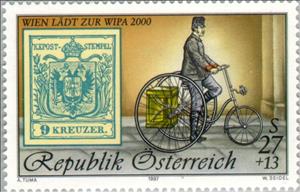Stamp: Stamp Exhibition WIPA 2000 (Austria 1997)
Stamp Exhibition WIPA 2000 (Austria 1997)
23 May (Austria ) within release Stamp Exhibition WIPA goes into circulation Stamp Stamp Exhibition WIPA 2000 face value 27+13 Austrian schilling
| Stamp Stamp Exhibition WIPA 2000 in catalogues | |
|---|---|
| Michel: | Mi:AT 2222 |
| Yvert et Tellier: | Yt:AT 2051 |
Stamp is horizontal format.
Also in the issue Stamp Exhibition WIPA:
- Stamp - Stamp Exhibition WIPA 2000 face value 27+13;
- Mini Sheet - Stamp Exhibition WIPA 2000 face value 4*(27+13);
Stamp Stamp Exhibition WIPA 2000 it reflects the thematic directions:
A vehicle (from Latin: vehiculum) is a mobile machine that transports people or cargo. Typical vehicles include wagons, bicycles, motor vehicles (motorcycles, trucks, buses), railed vehicles (trains, trams), watercraft (ships, boats), aircraft and spacecraft. Land vehicles are classified broadly by what is used to apply steering and drive forces against the ground: wheeled, tracked, railed or skied. ISO 3833-1977 is the standard, also internationally used in legislation, for road vehicles types, terms and definitions.
An exposition, in the most general sense, is an organized presentation and display of a selection of items. In practice, exhibitions usually occur within museums, galleries and exhibition halls, and World's fairs. Exhibitions can include many things such as art in both major museums and smaller galleries, interpretive exhibitions, natural history museums and history museums, and also varieties such as more commercially focused exhibitions and trade fairs.
Philately (/fɪˈlætəli/; fih-LAT-ə-lee) is the study of postage stamps and postal history. It also refers to the collection and appreciation of stamps and other philatelic products.While closely associated with stamp collecting and the study of postage, it is possible to be a philatelist without owning any stamps. For instance, the stamps being studied may be very rare or reside only in museums.
A bicycle, also called a pedal cycle, bike, push-bike or cycle, is a human-powered or motor-assisted, pedal-driven, single-track vehicle, with two wheels attached to a frame, one behind the other. A bicycle rider is called a cyclist, or bicyclist.
A coat of arms is an heraldic visual design on an escutcheon (i.e. shield), surcoat, or tabard. The coat of arms on an escutcheon forms the central element of the full heraldic achievement which in its whole consists of shield, supporters, crest, and motto. A coat of arms is traditionally unique to an individual person, family (except in the United Kingdom), state, organisation or corporation.





